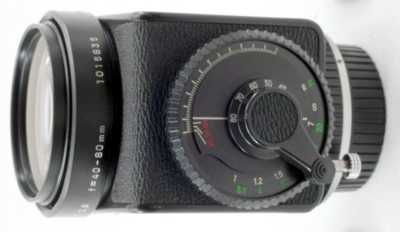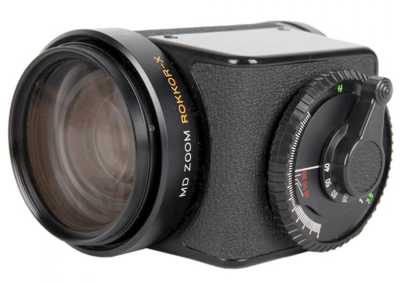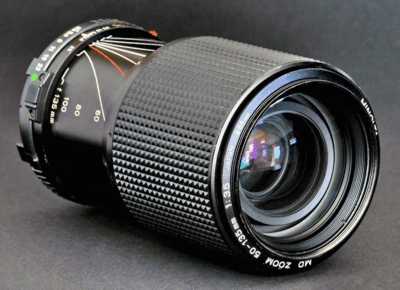MINOLTA NORMAL -TO-TELE ZOOM LENSES
LENS FEATURES
IMAGE
COMMENTS
FOCAL LENGTH: 40-80mm
f-STOPS: 2.8-22
PERIOD: 1972-1977
INSCRIPTION: MINOLTA LENS MADE IN JAPAN MC ZOOM ROKKOR-X
1:2.8 f=40-80mm
DESIGN: 12/12
FILTER: 55
DIAPHRAGM: auto
MC: yes
MD: no
CLOSE FOCUS: 1.2'
SIZE: 3.8"x3.9"
WEIGHT: 1lbs. 4.5oz.

A new lens to the Minolta line-up of SLR lenses in the MC Rokkor-X series. Many consider this to be Minolta's oddest lens, not because of the range of the focal length, but because of the shape of the lens. To achieve the constant f2.8 maximum aperture, Minolta engineers designed the lens with the zoom and focus controls on a raised block on the left-hand side of the lens, instead of the common collars around the lens. As a result of its unusual appearance, many people assume that the 40-80mm is some sort of auto-focusing lens, or a lens for a movie or digital camera. The lens normally focuses to 3.3 feet, but there is a macro button that allows it to get as close as 1.2 feet. The lens is fairly light, given its size, but the zooming controls have the reputation of permanently freezing in place, and most repair shops are not willing to work on such an odd lens. The results from the lens are quite sharp, but it does suffer from some barrel and pincushion distortion. The barrel distortion is at it's worst at 40mm, while the pincushion distortion is most noticeable at 80mm. At 50mm, these aberrations cancel each other out, and even at the extremes, the amount of distortion is not apparent -- unless you are taking pictures of brick walls! Despite these aberrations, the lens is very sharp -- even at f2.8. Minolta sacrificed one type of aberration in order to minimize the other. It's a quite uncommon lens and is very pricey, even though it is often sold in a frozen position. The 40-80mm has a 55mm filter thread and an additional 62mm front thread that can only be used for a lens shade. Despite the size, it can be the perfect replacement for a normal lens, wide angle lens, telephoto lens and macro lens. A whole bag of lenses in one! Sure, Minolta made other mid-range zooms, some with wider ranges -- like the 28-85 and the 35-105 -- but these are slower lenses and have variable apertures. If the 40-80mm is not an option for you, the best option might be to decide between Minolta's several 35-70mm zooms.
FOCAL LENGTH: 40-80mm
f-STOPS: 2.8-22
PERIOD: 1977-1981
INSCRIPTION: MINOLTA LENS MADE IN JAPAN MD ZOOM ROKKOR-X
1:2.8 f=40-80mm
DESIGN: 12/12
FILTER: 55
DIAPHRAGM: auto
MC: yes
MD: yes
CLOSE FOCUS: 1.2'
SIZE: 3.8"x3.9"
WEIGHT: 1lbs. 4.5oz.

An updated version of the MC Rokkor-X 40-80mm 2.8 zoom with the typical changes of the MD Rokkor-X series. It still suffers from the same mechanical problems as it's predecessor.
FOCAL LENGTH: 50-100mm
f-STOPS: 3.5-22
PERIOD: 1958-1966
INSCRIPTION: MINOLTA AUTO ZOOM ROKKOR 1:3.5 f=50-100mm
DESIGN: 15/9
FILTER: 77
DIAPHRAGM: auto
MC: no
MD: no
CLOSE FOCUS: 6.6'
SIZE: 5.0"x3.2"
WEIGHT: 1lb. 14oz.

From the early 1960's, Minolta started making zoom lenses, but the first round didn't sell particularly well and it would be about 15 years before Minolta ventured down the zoom road in force. The biggest problem was cost. Take Minolta's third zoom lens, the 50-100mm Auto Rokkor zoom, for example. While a typical 50mm or 100mm lens had about five glass elements, this zoom lens had 15 -- and cost twice as much as buying a comparable 50 and 100mm pair! Even if Minolta had sold an 85mm at the time, it would have been cheaper to buy the separate lenses. But not only did it cost much more, the 50-100mm zoom was slow, heavy and big. It is a two-touch zoom, but it does have a static aperture. The front of lens rotates as the lens is focused, but the lens has an auto-diaphragm. It also sports a DOF preview button and comes with a wide 77mm lens shade -- which it really needs. Like all of Minolta's early zoom lenses, it's hard to find and priced by collectors.
FOCAL LENGTH: 50-135mm
f-STOPS: 3.5-22
PERIOD: 1977-1981
INSCRIPTION: MINOLTA MD ZOOM ROKKOR-X 50-135mm 1:3.5 LENS
MADE IN JAPAN
DESIGN: 12/10
FILTER: 55
DIAPHRAGM: auto
MC: yes
MD: yes
CLOSE FOCUS: 4.9'
SIZE: 2.7"x4.6"
WEIGHT: 1lbs. 1oz.

A new lens to the Minolta line-up of SLR lenses in the MD Rokkor-X series. It's a one-touch zoom and covers a very useful range of focal lengths. In many ways, it is the perfect portrait lens. It allows you to shoot full-length portraits as well as close-up head-shots. You don't lose much speed over a 135mm f2.8 and the constant aperture makes electronic flash calculations a breeze.
FOCAL LENGTH: 50-135mm
f-STOPS: 3.5-32
PERIOD: 1981-present
INSCRIPTION: MINOLTA MD ZOOM 50-135mm 1:3.5 JAPAN ø55mm
DESIGN: 12/10
FILTER: 55
DIAPHRAGM: auto
MC: yes
MD: yes
CLOSE FOCUS: 4.9'
SIZE: 2.7"x4.6"
WEIGHT: 1lbs. 1oz.

An updated version of the MD Rokkor-X 50-135mm 3.5 zoom with the typical changes of the MD Minolta series. In addition, a depth-of-field scale was added to the zoom barrel and the minmimum f-stop was changed from f22 to f32.